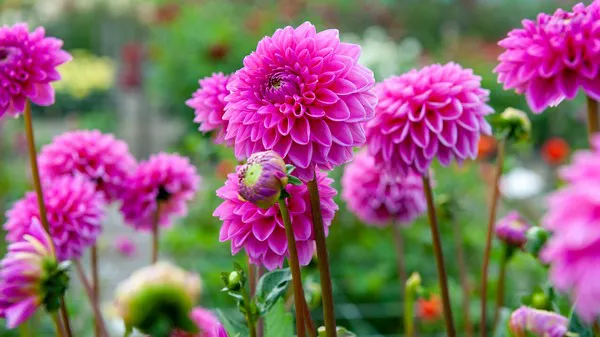Flowers have long been associated with various meanings and symbols, including wealth and prosperity. Whether used in floral arrangements, gardens, or as gifts, certain flowers have a rich cultural history of representing affluence and abundance. From ancient civilizations to modern times, the symbolism of flowers has remained significant, with some blooms being particularly emblematic of wealth. In this article, we will explore the top 10 flowers that symbolize wealth, delving into their cultural significance, historical use, and unique characteristics.
1. Peony (Paeonia)
The peony is often regarded as the king of flowers in Chinese culture and is highly revered for its association with wealth, honor, and prosperity. Renowned for its large, luxurious blooms and lush foliage, the peony has been cultivated in China for thousands of years and is a symbol of opulence and good fortune. In traditional Chinese art and literature, the peony is frequently depicted as a symbol of wealth and success, adorning palaces, gardens, and ceremonial attire.
2. Lotus (Nelumbo nucifera)
The lotus holds profound symbolism in various cultures, particularly in Asia, where it is revered as a sacred flower symbolizing purity, enlightenment, and prosperity. In Hinduism and Buddhism, the lotus is associated with divine beauty, spiritual growth, and the transcendence of worldly suffering. Its ability to emerge from murky waters and bloom into a pristine flower has led to its portrayal as a metaphor for overcoming obstacles and achieving wealth and success.
3. Orchid (Orchidaceae)
With its exotic beauty and diverse array of species, the orchid has long been associated with elegance, luxury, and wealth. In ancient Greece, orchids were linked to fertility and virility, while in ancient China, they were prized for their rarity and beauty, symbolizing refinement and nobility. Today, orchids remain highly sought after for their ornamental value and are often used in upscale floral arrangements and décor, reflecting a sense of sophistication and prosperity.
4. Lily (Lilium)
Lilies have a rich cultural significance and are often associated with purity, royalty, and prosperity. In ancient Egypt, lilies were considered sacred flowers associated with the goddess Isis and were frequently depicted in religious ceremonies and artwork. In Christian symbolism, the Madonna lily is a symbol of purity and virtue, while in Chinese culture, the tiger lily represents wealth and abundance. With their elegant blooms and rich fragrance, lilies continue to be prized as symbols of opulence and prosperity.
5. Sunflower (Helianthus annuus)
The sunflower is a vibrant and iconic flower known for its association with warmth, positivity, and abundance. Native to the Americas, sunflowers have a long history of cultural significance among indigenous peoples, who revered them as symbols of vitality and prosperity. In European folklore, sunflowers were associated with the sun god and were believed to bring good luck and wealth to those who cultivated them. Today, sunflowers remain popular symbols of optimism and prosperity, often adorning gardens, bouquets, and home décor.
6. Chrysanthemum (Chrysanthemum spp.)
Chrysanthemums have a rich cultural history and are highly regarded for their beauty, longevity, and symbolism. In China, the chrysanthemum is known as the “flower of the nine noble virtues” and is revered for its association with longevity, happiness, and prosperity. In Japan, chrysanthemums are the national flower and are a symbol of the imperial family, representing longevity and rejuvenation. With their diverse range of colors and shapes, chrysanthemums are popular symbols of wealth and abundance in various cultures around the world.
7. Iris (Iris spp.)
The iris is a strikingly beautiful flower known for its distinctive shape and vibrant colors. In Greek mythology, the iris was a symbol of the goddess Iris, who served as a messenger of the gods and was associated with rainbows and prosperity. In ancient Egypt, irises were highly prized for their medicinal properties and were depicted in royal tombs and ceremonial art. Today, irises are cherished for their elegance and symbolism, representing wealth, wisdom, and divine protection.
8. Magnolia (Magnolia spp.)
Magnolias are revered for their exquisite beauty and timeless elegance, making them popular symbols of wealth and prosperity. Native to Asia and the Americas, magnolias have been cultivated for centuries for their ornamental value and fragrant blooms. In Chinese culture, magnolias are associated with nobility and purity, symbolizing grace, beauty, and prosperity. In the southern United States, magnolias are emblematic of hospitality and wealth, often adorning grand estates and gardens.
9. Tulip (Tulipa spp.)
Tulips have a long and storied history, with their origins dating back to ancient Persia and the Ottoman Empire. In the 17th century, tulips became highly coveted commodities in Europe, particularly in the Netherlands, where they were regarded as symbols of wealth and prosperity. During the Dutch Golden Age, tulip bulbs were traded at exorbitant prices, leading to the infamous “tulip mania” craze. Today, tulips remain popular symbols of abundance and prosperity, adorning gardens, bouquets, and floral arrangements worldwide.
10. Camellia (Camellia spp.)
The camellia is a symbol of beauty, love, and prosperity, revered for its exquisite blooms and cultural significance. Native to Asia, camellias have been cultivated for centuries for their ornamental value and medicinal properties. In Japan, the camellia is known as the “flower of the samurai” and is associated with courage, honor, and prosperity. In China, camellias are symbols of love and devotion, often given as gifts to express admiration and affection. With their lush foliage and vibrant blooms, camellias continue to be cherished as symbols of wealth and abundance.
Conclusion
In conclusion, flowers have long been revered for their beauty, fragrance, and symbolism, with certain blooms holding special significance as symbols of wealth and prosperity. Whether used in cultural ceremonies, religious rituals, or decorative arrangements, these flowers evoke a sense of opulence and abundance, enriching our lives with their timeless elegance and cultural heritage. By appreciating the symbolic value of these flowers, we can cultivate a deeper connection to nature and the rich tapestry of human history.


